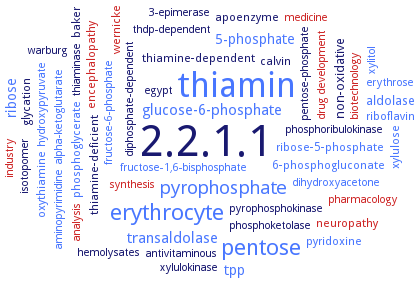2.2.1.1: transketolase
This is an abbreviated version!
For detailed information about transketolase, go to the full flat file.

Word Map on EC 2.2.1.1 
-
2.2.1.1
-
thiamin
-
pentose
-
erythrocyte
-
pyrophosphate
-
transaldolase
-
glucose-6-phosphate
-
tpp
-
ribose
-
5-phosphate
-
aldolase
-
non-oxidative
-
glycation
-
encephalopathy
-
pyridoxine
-
apoenzyme
-
phosphoglycerate
-
wernicke
-
baker
-
oxythiamine
-
neuropathy
-
ribose-5-phosphate
-
thiamine-deficient
-
xylulose
-
thiamine-dependent
-
6-phosphogluconate
-
riboflavin
-
calvin
-
pharmacology
-
drug development
-
biotechnology
-
pentose-phosphate
-
xylulokinase
-
industry
-
alpha-ketoglutarate
-
dihydroxyacetone
-
warburg
-
phosphoketolase
-
3-epimerase
-
hemolysates
-
pyrophosphokinase
-
xylitol
-
phosphoribulokinase
-
thiaminase
-
hydroxypyruvate
-
aminopyrimidine
-
fructose-6-phosphate
-
medicine
-
fructose-1,6-bisphosphate
-
antivitaminous
-
erythrose
-
egypt
-
thdp-dependent
-
diphosphate-dependent
-
synthesis
-
isotopomer
-
analysis
- 2.2.1.1
- thiamin
- pentose
- erythrocyte
- pyrophosphate
- transaldolase
- glucose-6-phosphate
- tpp
- ribose
- 5-phosphate
- aldolase
-
non-oxidative
-
glycation
- encephalopathy
- pyridoxine
-
apoenzyme
- phosphoglycerate
- wernicke
-
baker
- oxythiamine
- neuropathy
- ribose-5-phosphate
-
thiamine-deficient
- xylulose
-
thiamine-dependent
- 6-phosphogluconate
- riboflavin
-
calvin
- pharmacology
- drug development
- biotechnology
-
pentose-phosphate
- xylulokinase
- industry
- alpha-ketoglutarate
- dihydroxyacetone
-
warburg
- phosphoketolase
-
3-epimerase
- hemolysates
-
pyrophosphokinase
- xylitol
- phosphoribulokinase
- thiaminase
- hydroxypyruvate
- aminopyrimidine
- fructose-6-phosphate
- medicine
- fructose-1,6-bisphosphate
-
antivitaminous
- erythrose
-
egypt
-
thdp-dependent
-
diphosphate-dependent
- synthesis
-
isotopomer
- analysis
Reaction
Synonyms
glycolaldehydetransferase, STM14_2885, STM14_2886, TK16, TKA, TKL, TKL1, Tkl2, TKT, TKT10, TKT3, TKT7, TktA, TktB, TKTc, TKTL-1, TKTL1, TKTL2, TKTp, transketolase, transketolase 10, transketolase 3, transketolase 7, transketolase A, transketolase B, transketolase like 1, transketolase-1, transketolase-like 1, transketolase-like enzyme 1, transketolase-like-1, transketolase-like-1-gene, transketolase-like-2
ECTree
Advanced search results
General Stability
General Stability on EC 2.2.1.1 - transketolase
Please wait a moment until all data is loaded. This message will disappear when all data is loaded.
1-butyl-3-methylimidazolium chloride in the range 30-50% (w/v) in water maintains the total activity of the enzyme
holoenzyme reconstituted in the presence of Ca2+ is more stable than its Mg2+ counterpart
-


 results (
results ( results (
results ( top
top





